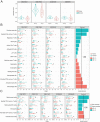Smoker and non-smoker lung adenocarcinoma is characterized by distinct tumor immune microenvironments
- PMID: 30288364
- PMCID: PMC6169585
- DOI: 10.1080/2162402X.2018.1494677
Smoker and non-smoker lung adenocarcinoma is characterized by distinct tumor immune microenvironments
Abstract
Tobacco smoking causes DNA damages in epithelial cells and immune dysfunction in the lung, which collectively contribute to lung carcinogenesis and progression. However, potential mechanisms by which tumor-infiltrating immune cells contribute to lung cancer survival and their differential contributions in ever-smokers and never-smokers are not well studied. Here, we performed integrative analysis of 11 lung cancer gene-expression datasets, including 1,111 lung adenocarcinomas and 200 adjacent normal lung samples. Distinct pathways were altered in lung carcinogenesis in ever-smokers and never-smokers. Never-smoker patients had a better outcome than ever-smoker patients. We characterized compositional patterns of 21 types of immune cells in lung adenocarcinomas and revealed the complex association between immune cell composition and clinical outcomes. Interestingly, we found two subsets of immune cells, mast cells and CD4+ memory T cells, which had completely opposite associations with outcomes in resting and activated status. We further discovered that several chemokines and their associated receptors (e.g., CXCL11-CX3CR1 axis) were selectively altered in lung tumors in response to cigarette smoking and their abundances showed stronger correlation with fractions of these immune subsets in ever-smokers than never-smokers. The status switched from the resting to activated forms in mast cells and CD4+ memory T cells might manifest some important processes induced by cigarette smoking during tumor development and progression. Our findings suggested that aberrant activation of mast cells and CD4+ memory T cells plays crucial roles in cigarette smoking-induced immune dysfunction in the lung, which contributes to tumor development and progression.
Keywords: Cancer survival; gene expression; immune; lung cancer; microenvironments; tobacco smoking.
Figures





Similar articles
-
Distinct immune microenvironment of lung adenocarcinoma in never-smokers from smokers.Cell Rep Med. 2023 Jun 20;4(6):101078. doi: 10.1016/j.xcrm.2023.101078. Epub 2023 Jun 9. Cell Rep Med. 2023. PMID: 37301197 Free PMC article.
-
The clinicopathological and survival differences between never and ever smokers with non-small cell lung cancer.J BUON. 2014 Apr-Jun;19(2):453-8. J BUON. 2014. PMID: 24965406
-
Gender, histology, and time of diagnosis are important factors for prognosis: analysis of 1499 never-smokers with advanced non-small cell lung cancer in Japan.J Thorac Oncol. 2010 Jul;5(7):1011-7. doi: 10.1097/JTO.0b013e3181dc213e. J Thorac Oncol. 2010. PMID: 20502360
-
Lung cancer mutation profile of EGFR, ALK, and KRAS: Meta-analysis and comparison of never and ever smokers.Lung Cancer. 2016 Dec;102:122-134. doi: 10.1016/j.lungcan.2016.10.010. Epub 2016 Oct 25. Lung Cancer. 2016. PMID: 27987580 Review.
-
Mechanisms of Disease: signal transduction in lung carcinogenesis -- a comparison of smokers and never-smokers.Nat Clin Pract Oncol. 2008 Oct;5(10):610-8. doi: 10.1038/ncponc1181. Epub 2008 Jul 15. Nat Clin Pract Oncol. 2008. PMID: 18628738 Review.
Cited by
-
Inherited lung cancer: a review.Ecancermedicalscience. 2020 Jan 29;14:1008. doi: 10.3332/ecancer.2020.1008. eCollection 2020. Ecancermedicalscience. 2020. PMID: 32104210 Free PMC article. Review.
-
Impact of Smoking History on Response to Immunotherapy in Non-Small-Cell Lung Cancer: A Systematic Review and Meta-Analysis.Front Oncol. 2021 Aug 23;11:703143. doi: 10.3389/fonc.2021.703143. eCollection 2021. Front Oncol. 2021. PMID: 34497760 Free PMC article.
-
Lung Cancer in Never Smokers: Delving into Epidemiology, Genomic and Immune Landscape, Prognosis, Treatment, and Screening.Lung. 2023 Dec;201(6):521-529. doi: 10.1007/s00408-023-00661-3. Epub 2023 Nov 16. Lung. 2023. PMID: 37973682 Review.
-
Genetic and microenvironmental differences in non-smoking lung adenocarcinoma patients compared with smoking patients.Transl Lung Cancer Res. 2020 Aug;9(4):1407-1421. doi: 10.21037/tlcr-20-276. Transl Lung Cancer Res. 2020. PMID: 32953513 Free PMC article.
-
Non-Smoking-Associated Lung Cancer: A distinct Entity in Terms of Tumor Biology, Patient Characteristics and Impact of Hereditary Cancer Predisposition.Cancers (Basel). 2019 Feb 10;11(2):204. doi: 10.3390/cancers11020204. Cancers (Basel). 2019. PMID: 30744199 Free PMC article. Review.
References
-
- Pao W, Miller V, Zakowski M, Doherty J, Politi K, Sarkaria I, et al. EGF receptor gene mutations are common in lung cancers from “never smokers” and are associated with sensitivity of tumors to gefitinib and erlotinib. Proc Natl Acad Sci. 2004;101:13306–13311. doi:10.1073/pnas.0405220101. - DOI - PMC - PubMed
-
- Ahrendt SA, Decker PA, Alawi EA, Yr YR Zhu, Sanchez-Cespedes M, Yang SC, et al. Cigarette smoking is strongly associated with mutation of the K-ras gene in patients with primary adenocarcinoma of the lung. Cancer. 2001;92:1525–1530. - PubMed
-
- Suzuki H, Takahashi T, Kuroishi T, Suyama M, Ariyoshi Y, Takahashi T, et al. p53 mutations in non-small cell lung cancer in Japan: association between mutations and smoking. Cancer Res. 1992;52:734–736. - PubMed
Publication types
LinkOut - more resources
Full Text Sources
Research Materials
